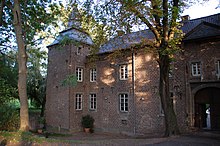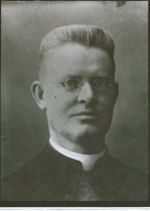Blatzheim
|
Blatzheim
City of Kerpen
|
||
|---|---|---|
| Coordinates: 50 ° 51 ′ 20 ″ N , 6 ° 37 ′ 56 ″ E | ||
| Height : | 102 m above sea level NHN | |
| Area : | 23.83 km² | |
| Residents : | 3535 (Dec. 31, 2017) | |
| Population density : | 148 inhabitants / km² | |
| Incorporation : | 1st January 1975 | |
| Postal code : | 50171 | |
| Area code : | 02275 | |
|
Location of Blatzheim in North Rhine-Westphalia |
||
|
The center of Blatzheim
|
||
Blatzheim is a district of the city of Kerpen in the Rhein-Erft district and is roughly in the middle of a city triangle made up of Aachen , Bonn and Düsseldorf and about 25 km from Cologne . This Kerpen district also includes the places Bergerhausen , Niederbolheim , Dorsfeld , Geilrath and other farms.
→ See also the list of mills at Neffelbach , Blatzheim Cistercian Abbey
history
The history of the place Blatzheim goes back a long way. There are many finds from Roman times. A large estate from the 2nd or 3rd century has been found between Blatzheim, Bergerhausen and the Clemenshöfen, a homestead near Blatzheim. The two Roman roads Cologne – Aachen – Maastricht and Zülpich - Neuss ( Roman road Trier – Neuss ) probably crossed in Blatzheim .
The name Blatzheim is mentioned in writing for the first time in a document dated May 25, 1057. With this document, the Archbishop of Cologne Anno II gave his property in Blatzheim to Queen Richeza of Poland for life.
Blatzheim was with the places Bergerhausen, Dorsfeld, Geilrath and Niederbolheim a judicial district in the Electoral Cologne office of Lechenich .
A family from Bergerhausen is first mentioned in 1291.
In Niederbolheim, a liege of the Archbishop of Cologne built a knight's seat in the 14th century.
Dorsfeld and Geilrath have been known since the 11th century.
The castle Bergerhausen in Bergerhausen and the commander of the castle in Blatzheim still bear witness to strong fortifications. The street name "Klosterhof St. Peter" refers to the Cistercian monastery there and the street "Peters Mühle" is reminiscent of one of the many water mills along the Neffelbach . Many other buildings from the church to the primary school document old and new history and are in the list of monuments. Many buildings only had a short lifespan, such as the Blatzheim indoor swimming pool. The sports field changed its location three times within a few decades.
Well-known and less well-known personalities are also connected with the history of Blatzheim. Some have or only had meaning for the place, some beyond. The journeyman's father and beatified Adolph Kolping, for example, was encouraged and supported by the Blatzheim pastor Lauffs. In 1913/14 the " Blatzheimer Katholikenstreit " broke out, which is connected with the pastor August Kugelmeier. Clemens Baron von Loé was the last nobleman at Bergerhausen Castle. Jakob Dohmen shaped the political life of Blatzheim after the Second World War, which was also expressed in the fact that the formerly politically “red” place has now become a “black”, conservative place. From 1958 to 1975 he was mayor of Blatzheim. Up to this year Blatzheim was also an independent municipality , but was assigned to the city of Kerpen by the Cologne Act of 1974 with effect from January 1, 1975. As a result, Blatzheim no longer has its own mayor; its citizens are now represented by a local mayor . Albert Weingarten (CDU) currently holds this office. Status: July 2011
Other stories are also known, for example about the Corpus Christi procession , which ran through the entire district of Blatzheim until 1830 and lasted from 6 a.m. to 6 p.m. In Dorsfeld people strengthened themselves. The Christian doctrine was held there for women and children, and the men shot a wooden bird and smeared their throats. Alfons Commer reports that under these circumstances the cross-bearer once threw the cross at a hare.
Blatzheim Catholic dispute
The so-called “Blatzheimer Katholikenstreit” of 1913/1914 caused a sensation far beyond the town's borders. The trigger for this was the dispute between the pastor, church council and mayor about the construction of a new church for the place, which was necessary because the old church was considered too small and in need of renovation .
The new pastor August Kugelmeier, who started his service in Blatzheim on August 1st, 1913, saw the construction of this church as an important and quickly implemented task. However, he met resistance from the church council , represented by the deputy chairman Baron von Loë and the mayor Reichert. Although they did not want to prevent the construction, they still wanted to take a few more years. The reason they alleged was that there was a cemetery next to the church on parish land that would have stood in the way of the planned expansion of the church. So here a reburial of the dead had to be clarified and the property had to be acquired by the community. The church council and mayor were also assumed to delay the construction in order to be able to collect more interest from the monies set aside for the construction.
In the dispute over the church building, the tones became increasingly sharp and it increasingly developed into a dispute between the wealthy of the place - including von Loë - and the rest of the population, an agreement was no longer in sight. With Kugelmeier's transfer on April 29, 1914, after less than a year of service in Blatzheim, the dispute escalated further and there were demonstrations and violent riots in which houses were smeared and barns were set on fire and finally not before the use of firearms was recoiled. These riots lasted for several weeks and even after they ended, the topic remained highly controversial in the town. Only with the beginning of the First World War did it take a back seat.
The construction of a new church finally began in 1923 and was consecrated in 1925.
Bürgewald
Blatzheim is one of the so-called Bürgewald communities that owned the rights to the Bürgewald (Hambacher Forest). According to the legend, this is due to the holy Arnold von Arnoldsweiler , through the legendary "Ride around the Bürgewald". The main town of the Bürgewald communities is Arnoldsweiler . There the Blatzheimers had to offer a candle to Saint Arnold on Whit Tuesday, later on Whit Monday. This wax interest was only canceled in the 19th century.
traffic
For a long time the federal highways 264 and 477 ran through Blatzheim, but since November 2001 they have been used as bypass roads around Blatzheim. In an easterly direction, the new road leads directly to the A 61 , Türnich junction .
To the public transport Blatzheim is connected via two bus lines that day once every hour to Düren or after Buir and Kerpen run. In Buir there is a connection to the S-Bahn to Cologne.
literature
- Hermann Hinz : Archaeological finds and monuments of the Rhineland , Volume 2: Bergheim district . Rheinland-Verlag, Düsseldorf 1969, pp. 208–218 and plate 61 (Roman villa)
Web links
Individual evidence
- ↑ Distribution to the districts in 2018. In: Website of the city of Kerpen. Retrieved February 9, 2019 .
- ↑ Martin Bünermann, Heinz Köstering: The communities and districts after the municipal territorial reform in North Rhine-Westphalia . Deutscher Gemeindeverlag, Cologne 1975, ISBN 3-555-30092-X .
- ↑ Document from 1360 to confirm the wax interest, by the Duke of Jülich.
- ↑ On the dam around the village, Kölner Stadt-Anzeiger, November 16, 2001





